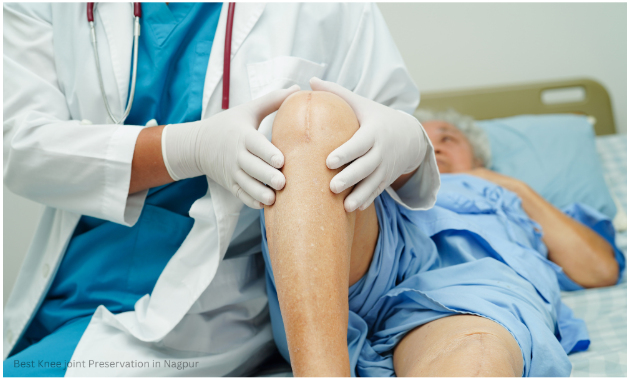Best Knee joint Preservation in Nagpur

Anatomy
The knee joint functions as an essential hinge joint, connecting the femur, or thigh bone, to the tibia, also known as the shin bone, and is protected by the patella, commonly called the kneecap. Furthermore, it includes menisci, ligaments, and cartilage, which together provide cushioning, stability, and flexibility. These components are vital for facilitating weight-bearing activities, including walking, running, and climbing stairs.
Common Causes of Knee Joint Problems
Different factors can contribute to injury in the knee joint, leading to pain and restricted mobility. Recognizing these underlying causes is essential for the successful preservation of the knee joint.
- Osteoarthritis: This condition is characterized by the progressive deterioration of cartilage within the joints, resulting in increased friction and discomfort in the knee area.
- Rheumatoid Arthritis: This is an autoimmune condition that primarily affects the joint tissues, leading to inflammation and subsequent damage to the knee
- Sports Injuries: Common injuries, including ligament tears (such as ACL and MCL) and meniscal damage, frequently occur in athletes and can significantly impair the stability of the knee joint.
Obesity: Excess body weight places undue stress on the knee joints, which can hasten the deterioration of cartilage and elevate the likelihood of joint degeneration.
Aging: The natural aging process leads to the gradual decline of joint structures, often resulting in diminished cartilage and reduced functionality of the joints, particularly in older adults.
Knee Joint Treatment Options
A variety of treatment options are accessible to maintain knee function and reduce discomfort, tailored to the severity of the condition.
Non-Surgical Treatments
- Physical Therapy: Engaging in exercises designed to improve the strength and functionality of the knee is crucial for the preservation of the knee joint. By fortifying the muscles surrounding the knee, one can alleviate the stress placed on the joint itself.
- Medications: The use of non-steroidal anti-inflammatory drugs (NSAIDs) can effectively reduce pain and inflammation in the knee joint, providing temporary relief and supporting functional maintenance.
- Injections: The administration of corticosteroids or hyaluronic acid can offer short-term relief from pain and inflammation, thereby enhancing mobility and overall quality of life.
- Lifestyle Modifications: Adopting a healthy weight and participating in low-impact activities, such as swimming or cycling, can lessen the burden on the knee joints, thereby preserving their functionality and minimizing the risk of injury.
Surgical Treatments
In situations where non-surgical approaches prove inadequate, surgical alternatives may be explored.
- Arthroscopy: This is a minimally invasive technique employed to address minor injuries, including torn menisci or damaged cartilage, which aids in maintaining knee joint functionality with a reduced recovery period.
- Partial Knee Replacement: This surgical procedure involves replacing only the affected compartment of the knee, thereby facilitating greater preservation of the knee joint compared to a total knee replacement.
- Total Knee Replacement (TKR): In instances of significant damage, this extensive procedure entails the replacement of the entire knee joint. While it is effective, it is generally regarded as a last option to sustain joint function.
Orthopedic Assessment for Knee Joint Treatment
Orthopedic specialists perform thorough evaluations prior to suggesting a treatment plan, which encompass:
- Medical History Evaluation: Reviewing the patient’s symptoms, past treatments, and familial medical background to identify potential risk factors that could affect knee health.
- Physical Examination: Assessing joint mobility, alignment, and stability, which yields critical insights into the degree of knee joint damage and informs the optimal preservation strategy.
- Imaging Assessments: Employing X-rays, MRI scans, and CT scans to evaluate the structural condition of the knee joint, facilitating an accurate diagnosis of any injuries or degenerative changes.
- Functional Assessment: Evaluating mobility and limitations in daily activities, which aids in understanding the functional implications of knee problems and identifying the most appropriate treatment options.
Post-Treatment Recovery and Care
The successful management of knee joint issues involves more than just surgical procedures. The core components of the rehabilitation process are:
Physiotherapy: Essential for regaining strength, flexibility, and mobility in the knee joint following surgery or injury, physiotherapy is vital for the long-term preservation of knee function.
Follow-Up Appointments: Regular consultations with your orthopedic specialist are important for ensuring adequate healing, tracking progress, and addressing any issues or complications that may arise during the recovery process.
Lifestyle Adjustments: Embracing a balanced diet and participating in low-impact exercises are crucial for sustaining knee health and preventing additional joint deterioration.
Knee Joint Preservation: A Lifelong Commitment
Knee joint preservation is a continuous endeavor that encompasses a blend of proactive lifestyle modifications, consistent physical activity, weight control, and medical treatments as necessary. By dedicating themselves to the maintenance of joint health, individuals can mitigate the likelihood of significant knee problems and prolong the functional lifespan of their knee joints. The objective remains to safeguard and sustain the knee joint’s capacity to facilitate weight-bearing activities, whether through non-invasive approaches or surgical procedures, for many years ahead.